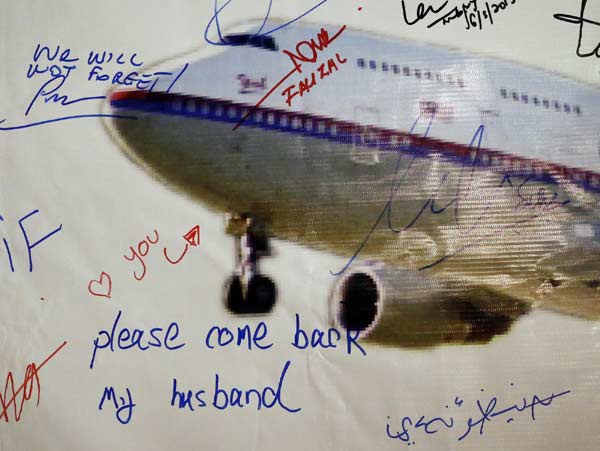Malaysia: If MH370 not found, it's back to the drawing board
(Agencies) Updated: 2015-03-07 19:12
 |
|
A message left on a board of remembrance by Kelly (last name not given), 29, the wife of a passenger aboard missing Malaysia Airlines Flight MH370, at a vigil ahead of the one-year anniversary of its disappearance in Kuala Lumpur, March 6, 2015. [Photo/Agencies] |
Ships looking for debris from the plane on the ocean floor off the coast of western Australia have so far scoured 44 percent of the 60,000-square-kilometer (23,166-square-mile) area the search has been focused on, Liow said. In the latest report he received Friday, he said the search team had identified 10 hard objects that still need to be analyzed.
Such findings, which often include trash and cargo containers from passing ships, have been common during the search, and so far no trace of wreckage has been located.
Australian Transport Minister Warren Truss said last week that if the plane isn't found by May, one option is to expand the hunt beyond the current search zone to a wider surrounding area.
Australian Prime Minister Tony Abbott said Thursday, "I can't promise that the search will go on at this intensity forever," but added that "we will continue our very best efforts to resolve this mystery and provide some answers."
Liow said an interim report on the investigation - a requirement under international civil aviation regulations - would be presented to the Malaysian government on Saturday and released to the public on Sunday. He didn't comment on it.
But he outlined measures his government has already undertaken, including plans to upgrade radar systems to cope with bigger traffic volume and a new tracking system on Malaysia Airlines flights that sends aircraft data every 15 minutes, instead of the previous 30 to 40 minutes.
Liow said the government has allocated 700 million ringgit ($190 million) for the improved radar.
He said that the radar upgrade had been in the works even before Flight 370 disappeared. The plane dropped off civilian radar when its transponder and other equipment were switched off shortly after takeoff from Kuala Lumpur, but was tracked for some time by Malaysia's military radar as it headed south across the country toward the Indian Ocean.






